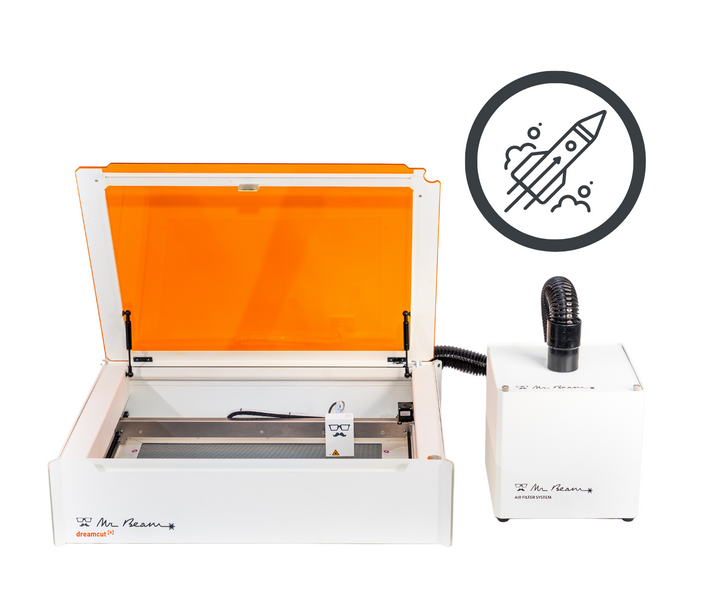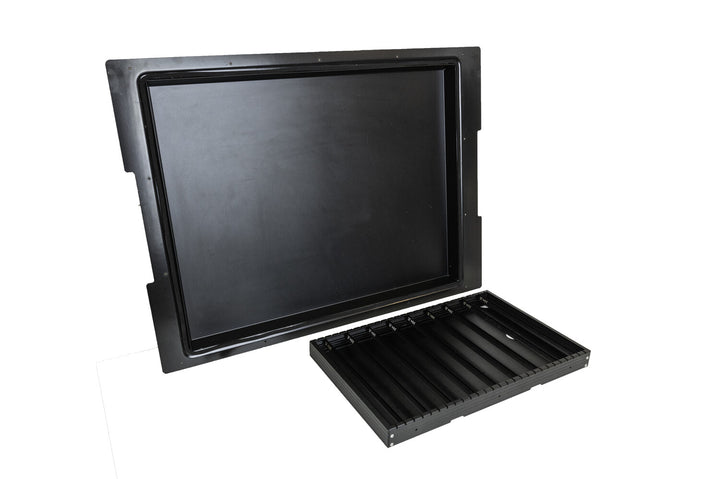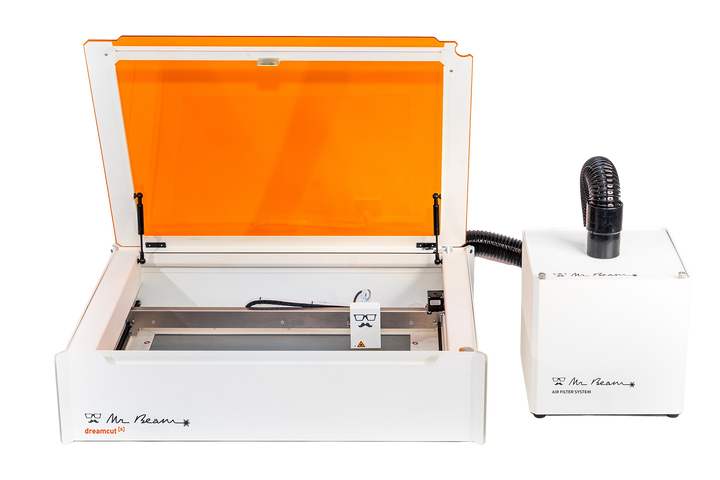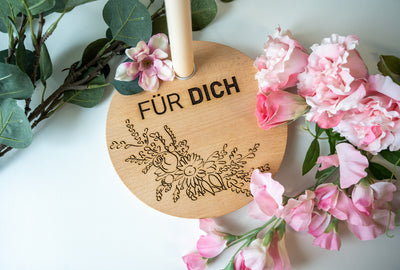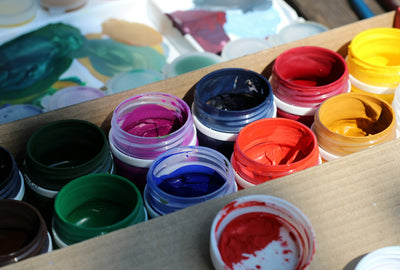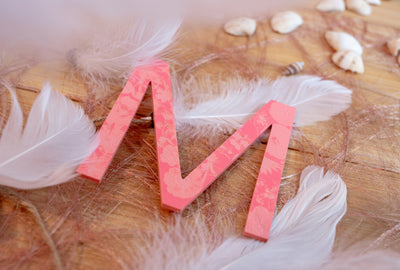Laser cutter and soldering iron in comparison

When it comes to joining metals together, most people immediately think of a soldering iron. The device consists of a handle and a heatable metal tip. This is used to heat the so-called solder, which is placed between two workpieces in the molten state and connects them to each other after they have cooled down. In this way, copper wires are connected to printed circuit boards in the electronics industry, plumbers connect copper pipes with a soldering iron and the device is also often used in jewellery production.

Soldering irons are not only used to permanently join two metals. With this device, you can engrave patterns and lettering in breakfast boards or accessories made of leather. For this work, the soldering iron guarantees constant heat so that you don't have to interrupt your hand movement when engraving. However, using a soldering iron has its limits. Materials such as paper or natural fibres in the fashion industry cannot be processed with this device, and the cutting through of wood does not take place with a precise cutting surface. In these cases, you should use a soldering iron alternative that works more precisely and gives you more room for manoeuvre. This includes the laser cutter.
With a laser cutter, shapes and patterns can be delicately cut out or engraved on different materials. Wood, plastic, leather, acrylic or paper are just some of the materials that you can process with a laser cutter. This is how cards, engravings, letters made of wood or wooden coasters are created, to name just a few examples. To manufacture these products, all you need is a two-dimensional drawing, which is implemented on the corresponding workpiece using a vector graphics program and a laser cutter as an alternative to a soldering iron.
Engraving and cutting functions at a glance
With a laser cutter as a soldering iron alternative, you can process different materials:
With the help of the light beam, complete shapes can be cut out of the various materials. You can also use a laser machine to carve out filigree patterns within a workpiece. For example, with poinsettias or for windows and doors in model houses to play with. You could not process all the materials mentioned with a soldering iron. Also, certain shapes and products require cutting of very fine geometries that cannot be achieved with a soldering iron.
In addition to cutting, you can use the laser cutter to personalize products by engraving them individually. Anything is possible, from individual letters to entire lettering or images. Each product is engraved identically using a laser cutter, which cannot be done by hand. Filigree engravings and matt effects on glasses, wooden boards or promotional items as well as in the production of stamps require the finest structures, for which the laser cutter is the better choice as a soldering iron alternative.
Precision and repeatability with a laser cutter

With the help of the computer, you create a template that the laser cutter converts to the workpiece with millimetre precision. The advantage of this way of working is obvious. The laser cutter transfers a unique template to the paper, wood or textiles in great detail over and over again, so that all products are identical. That would not be possible when working with a soldering iron. Although you can also transfer a desired image or shape to the wood in this case, reworking by hand will only produce unique pieces. Your hand movements will be different each time, if only slightly. For example, making a wooden jigsaw puzzle with a soldering iron is difficult because the size of the pieces will vary, and the cut edges will not match 100%.
With the soldering iron alternative, you work more precisely and faster. What you create by hand will in any case be surpassed by the laser cutter and its speed. When it comes to the private sphere, a little creative freedom, individual shapes and time investment are an expression of your own freedom of design. It doesn't matter if the soldering iron slips off a pattern or the size of wooden letters is different. In the commercial sector, on the other hand, you have to use the laser cutter as an alternative to a soldering iron. This is about accuracy, precision and repetition. When manufacturing packaging materials, standards regarding size must be observed. During laser cutting, textiles are already sealed at the cut edge by the heat, which would not be possible with a soldering iron. As a result, working with the soldering iron alternative is considered very effective, because post-processing processes such as grinding or mechanical sealing are not required.
Another aspect speaks in favour of a laser cutter. Instead of applying a time-consuming template to a certain material and engraving it with a soldering iron, the template on the computer saves time. All designs can be saved and called up when required. Ready-made templates are no longer required and do not have to be renewed regularly. The computer-aided production saves you time and material, and you can quickly switch between designs, text, graphics and photo elements when engraving. For laser cutting files, you need vector-based files, such as an SVG file or DXF file. If you want to engrave something, pixel graphics are sufficient.
Areas of application for the soldering iron alternative
Laser cutters can be found in more and more areas of application because they cut faster, more accurately and with fewer raw materials than would be possible by hand.

Examples of laser cutting applications:
- Cutting of packaging products
- Cutting leather for clothing or accessories
- product design
- personalized greeting and gift cards
- wedding decoration
- Toys such as puzzles or memory
- Model building for architects or hobby
- orthopedic technology
- and many more
If you use the laser cutter as a soldering iron alternative for the private sector, you benefit, for example, when producing individual or personalized puzzles. If you make these products by hand, the result will not match the perfection that comes from making them with a laser cutter.
Examples of laser engraving:
- Laser engraving for personalized decoration of various kinds
- Jewellery engravings
- Engravings on cell phone cases
- Engravings on trophies
- wood engravings
Engravings give a product an individual character. Whether it's the wedding dates on the ring box or the dedication on a key case - personalization turns a simple product into something very special. An engraved name or a motif that reflects a personal memory gives the owner the feeling of holding something very valuable in their hands. That's why engravings will never go out of style.
Conclusion on the soldering iron alternative
A soldering iron is used when you need to join metals together or want to give wooden items a one-off engraving that looks rustic. However, anything that is commercially produced or requires the cutting out of filigree shapes should be made with the soldering iron alternative - the laser cutter.
If there are many similar products, the use of a laser cutter is essential. The computer-controlled application ensures identical products, saves time and material, and also makes it possible for changes in the design to be implemented very quickly and without great effort.

